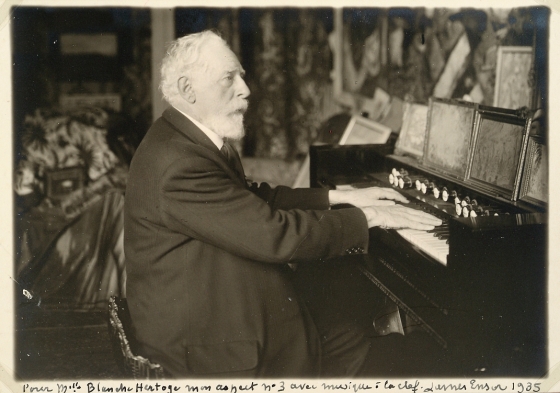This archived website ‘James Ensor. An online museum.’ is temporarily not being updated. Certain functionality (e.g. specific searches in the collection) may no longer be available. News updates about James Ensor will appear on vlaamsekunstcollectie.be. Questions about this website? Please contact us at info@vlaamsekunstcollectie.be.
James Ensor as Musician
Blanche Rousseau, Maurice des Ombiaux, Paul Haesaerts, Karel Jonckheere, Emma Lambotte and others have described how Ensor could entertain company in a comic manner by playing a pennywhistle in one of his nostrils, and with imposing, hilarious and fearsome improvisations played out on the piano.
Ensor was musically active already in the 1880's. The oldest composition of his that is preserved is the waltz Enlacements, dated 1905. Pietro Lanciani, who directed concerts in Ostend with Ensor's favourite dance and amusement music, revised a few of Ensor's pieces for symphonic orchestra and before the first World War had already given a few performances.
In 1906, the collectors Albin and Emma Lambotte presented the artist with a harmonium. Ensor composed various musical pieces that he collated into a six-part work for ballet, which he completed in 1911. La Gamme d'Amour consists out of the following parts: (1) Flirt des marionettes (1907), (2) Lento and Andante or Complainte et Berceuse, (3) Gamme d'amour (false), (4) Marche funèbre, (5) Enlacements (1905), (6) Pour une orgue de Barbarie (1911).
In these years, Ensor would from time to time attend concerts as the performer of his own piano pieces. He could not score his own compositions- as he played by memory-, and he played in an unorthodox way, with outstretched fingers, primarily the black keys of the keyboard. His music was scored and revised for symphonic orchestra by other musicians such as Michel Brusselmans and Georges Vriamont.
Ensor took his musical work very seriously. Without success, he undertook a few attempts to have the ballet La Gamme d'amour performed in the Théâtre des Champs Elysées or by La compagnie des Ballets russes, both in Paris. He complained about Brusselmans's orchestration of his composition that it would weaken its progressive character. Ensor related repeatedly that some musicians had at times compared his musical inventiveness with Claude Debussy (1862-1918). The prominent Belgian organ virtuoso, professor at the Antwerp conservatory, Brussels and Mechelen and international acclaimed composer, Auguste De Boeck, can but bring a mild praise for what he calls Ensor's simple dance tunes.
La Gamme d'amour was played for the first time by a student group of the Ostend music academy in 1917 and was consequently directed by Léon Delcroix in the exhibition hall in Brussels where George Giroux in 1920 organised a restrospective of Ensor's plastic work. François Franck financed the first full performance of the ballet for which Ensor also had indeed designed a staging, costumes and decor. With the choreography of Sonia Korty and under the direction of Flor Bosmans, Poppenliefde premiered on 27 March 1924 in the Royal Flemish Opera in Antwerp. In 1927, François Gaillard directed a few performances in the Théâtre Royal in Liège. There also exist sung variations and versions for fanfare, carillon and harp.
For the occasion of the grand retrospective in 1929 in the Brussels Palace of Fine Arts, Georges Vriamont secured the publication of an album with the staging, the score for piano and lithographs with the most important personages from the ballet. Furthermore, still two more compositions from the 1920's are known.

Herwig Todts






